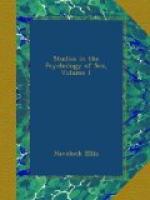Of the wide prevalence of the belief there can be no doubt. Among the Port Lincoln tribe of South Australia a lizard is said to have divided man from woman.[355] Among the Chiriguanos of Bolivia, on the appearance of menstruation, old women ran about with sticks to hunt the snake that had wounded the girl. Frazer, who quotes this example from the “Lettres edifiantes et curieuses,” also refers to a modern Greek folk-tale, according to which a princess at puberty must not let the sun shine upon her, or she would be turned into a lizard.[356] The lizard was a sexual symbol among the Mexicans. In some parts of Brazil at the onset of puberty a girl must not go into the woods for fear of the amorous attacks of snakes, and so it is also among the Macusi Indians of British Guiana, according to Schomburgk. Among the Basutos of South Africa the young girls must dance around the clay image of a snake. In Polynesian mythology the lizard is a very sacred animal, and legends represent women as often giving birth to lizards.[357] At a widely remote spot, in Bengal, if you dream of a snake a child will be born to you, reports Sarat Chandra Mitra.[358] In the Berlin Museum fuer Volkerkunde there is a carved wooden figure from New Guinea of a woman into whose vulva a crocodile is inserting its snout, while the same museum contains another figure of a snake-like crocodile crawling out of a woman’s vulva, and a third figure shows a small round snake with a small head, and closely resembling a penis, at the mouth of the vagina. All these figures are reproduced by Ploss and Bartels. Even in modern Europe the same ideas prevail. In Portugal, according to Reys, it is believed that during menstruation women are liable to be bitten by lizards, and to guard against this risk they wear drawers during the period. In Germany, again, it was believed, up to the eighteenth century at least, that the hair of a menstruating woman, if buried, would turn into a snake. It may be added that in various parts of the world virgin priestesses are dedicated to a snake-god and are married to the god.[359] At Rome, it is interesting to note, the serpent was the symbol of fecundation, and as such often figures at Pompeii as the genius patrisfamilias, the generative power of the family.[360] In Rabbinical tradition, also, the serpent is the symbol of sexual desire.
There can be no doubt that—as Ploss and Bartels, from whom some of these examples have been taken, point out—in widely different parts of the world menstruation is believed to have been originally caused by a snake, and that this conception is frequently associated with an erotic and mystic idea.[361] How the connection arose Ploss and Bartels are unable to say. It can only be suggested that its shape and appearance, as well as its venomous nature, may have contributed to the mystery everywhere associated with the snake—a mystery itself fortified by the association with women—to build up this world-wide belief regarding the origin of menstruation.




